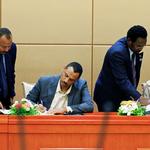Patience is key to a successful transition to democracy in Sudan
The Sudanese people have a vast experience of toppling military dictators through popular uprisings. Yet, the leaders of the October revolution in 1964 and the May revolution in 1985 were unable to establish a democratic political order in Sudan, as the parliamentary systems they created were ultimately overthrown by military coups in 1969 and 1989. What is different this time around?
The previous two uprisings began in and around the capital, were led by urban elites and failed to transcend the divide between the administrative centre and marginalized regions. The pattern of exploitation of the periphery by the centre continued after the 1964 and the 1985 popular uprisings and the armed rebellion against Khartoum in South Sudan, and later in Eastern Sudan and Darfur respectively. Ultimately, this led to their swift collapse.
There is an old joke that Sudanese politics are different every week, but if you come back after 10 years, they are exactly the same. Political power has been monopolized by Arab-Muslim riverine elites in Khartoum who have played a game of musical chairs in competing for state office. Described as a Muslim “ethnocracy,” these elites have dominated the country socially, politically and economically since before independence in 1956. Sudan expert Alex de Waal has argued that there are two dominant characteristics of the Sudanese state - the extreme economic and political inequality between Khartoum and the peripheries, and the failure of any single of the country’s elite groups to exercise power over the state – and that these characteristics are essentially to blame for Sudan’s chronic political instability.
There is an old joke that Sudanese politics are different every week, but if you come back after 10 years, they are exactly the same.
In contrast, the December 2018 uprising started in the rural regions, mainly in Atbara in the Northern Region and Damazin in the Blue Nile. After the headquarters of the Bashir’s Islamist political party was torched in Atbara, the protests quickly spread to other parts of Sudan, including Khartoum. Participants came from broad and unique backgrounds, across ethnicity, generation, class and gender. The protesters were led by an unstructured body of the Forces for Freedom and Change and the Sudan Professional Association, which is a union of professionals such as doctors, lawyers etc.
It took 4 months before the Bashir regime fell in early April, which gave time for marginalized groups to demand representation. The Sudanese prime minister over the 3-year long transition period announced his cabinet which included mainly technocrats without political party affiliations and representative of different regions, but importantly, women are also present. Although women were largely excluded from the negotiations between the military council and the coalition for freedom and change, the transitional government has more female representation than any other in Sudanese history, and a female chief justice has been appointed for the first time in history.
Although the transitional government is tasked with huge and difficult responsibilities, such as economic reform, sustainable peace and transitional justice, the game of musical chairs has been suspended at least for a transitional period of three years.
The long transitional period stands out as a unique feature of the 2019 revolution. In 1964 and 1985, political parties pressed for early elections, which explains the quick return to military dictatorships. Although the protesters are understandably impatient after three decades of political and economic mismanagement, the transitional government needs time to be able to introduce sustainable reform and set the stage for a transition to a democratic government. After the fall of Bashir, the traditional political parties started to press for another early election because they are in a hurry to gain access to power. Luckily, the coalition negotiating on behalf of the protesters have learnt the lesson from previous revolutions. However, this did not stop some of the traditional parties from still asking for early elections and insisting that neither the Freedom and Change Group nor the Sudan Professional Association are credible representatives of the general public in the country. The traditional parties can easily become spoilers, together with the armed groups which feel that they have been excluded from positions in the new governmental structure.
After the fall of Bashir, the traditional political parties started to press for another early election because they are in a hurry to gain access to power.
Patience is key to a successful transition. But how can Sudanese politics break with the historic pattern of musical chairs? And how can they overcome traditional political and economic exploitation of regions outside the cities? We need to give the transitional government time to ensure meaningful representation of marginalized groups and eventually a sustainable peace and development throughout the country.
This Sudan blog post is written by Abdel Ghaffar Ahmed, professor at University of Khartoum and Ahfad University for women




